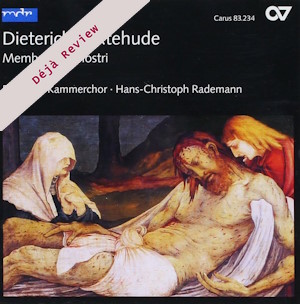
Déjà Review: this review was first published in July 2007 and the recording is still available.
Dieterich Buxtehude (c.1637-1707)
Cantatas
Membra Jesu nostri BuxWV 75 (c.1680)
War Gott nicht mit uns diese Zeit BuxWV 102
Walts Gott, mein Werk ich lasse BuxWV 103
Christina Kaiser (soprano), Anja Zügner (soprano), Alexander Schneider (alto), Tobias Hunger (tenor), Matthias Lutze (bass), Marek Rzepka (bass)
Dresden Kammerchor/Hans Rademann
rec. live, February 2007, Lukaskirche, Dresden, Germany
Carus 83.234 [69]
Membra Jesu nostri (The Limbs of our Jesus) is a series of seven compact cantatas based on the Latin text Rhytmica Oratio. Once ascribed to St. Bernard of Clairvaux it’s now thought to be by the Cistercian abbot Arnulf von Löwen who lived in the first half of the thirteenth century. Buxtehude is thought to have come across a 1633 printing of the text and to have written the score around 1680 whilst he was active in Lübeck. It can’t however be assumed with any certainty that it was ever performed there. The cyclical nature of it suggests a Passion setting.
The text concerns the membrum of Christ, seven body parts – feet, knees, hands, side, chest, heart and face. Each cantata is introduced by an instrumental sonata and this is followed by the biblical motto in the form of a tutti passage – with the exception of the fifth and sixth where it’s written for a smaller ensemble. The succeeding arias are based on Arnulf’s texts and then we have a reprise of the motto – except for the final cantata which ends in an Amen. The instrumental accompanying group consists of two violins, violone and basso continuo – though in the sixth we have a five part gamba consort. Vocally the cantatas are written in five parts – two sopranos, alto, tenor, and bass – or in three parts in the case of Nos. 5 and 6.
The textures of these cantatas are very finely realised in this premiere recording. The opening sonatas are brief, sometimes terse, but always expressive. That of the second, Ad genua, opens with tremulo for instance, varying the colours and rhythms expertly. The solo and choral contributions are of a generally high order. Fulsome warmth for instance is a feature of the Tutti of the second. Nor do the forces overlook the contrasting powers of expression that lie in the most textually laden of the passages – listen to the beautiful solo soprano line contrasting with the declamatory power of the Quid sunt section in the Ad manus cantata. Similarly the voci of cantata No.5, Ad pectus thins to almost nothing in increasing desolation. The most moving of the instrumental sonatas is the Sixth, Ad cor. It’s almost twice as long as any of the others and evinces an intensity that is notably well conveyed by the Dresden forces under Rademann.
Great care is also taken over the weight of single and choral entries; in the voci of Ad cor for example the voices have great purity and plangency, By the final cantata, Ad faciem, the writing has become increasingly affirmative and confident ending with a complex and vibrant Amen.
There are two further cantatas. The brief War Gott nicht mit uns diese Zeit is set to a text by Martin Luther. But the longer Walts Gott, mein Werk ich lasse will be better remembered as a very well-known Protestant hymn. It’s also the better work, more extensive, a touch more florid and also more intense.
Recorded live in the Lukaskirche this is yet another in Carus’s important catalogue of disc premieres. Diligently, impressively and with consistent success this company is building up a portfolio of very fine discs. The recording is excellent and the booklet contains texts and documentary material. First class all round.
Jonathan Woolf
Buying this recording via a link below generates revenue for MWI, which helps the site remain free



















